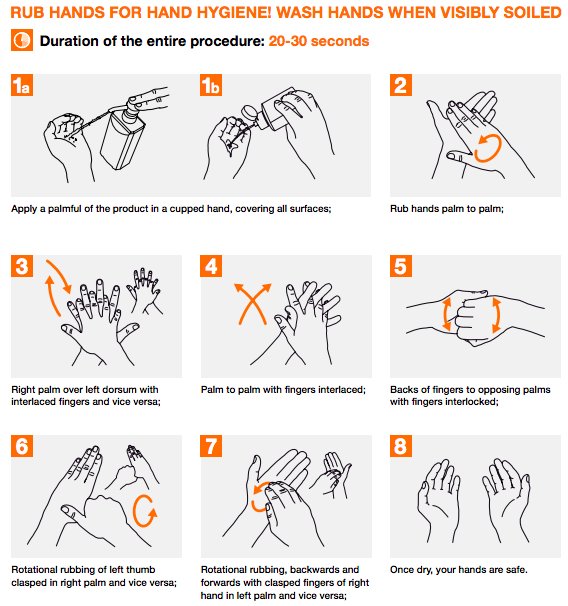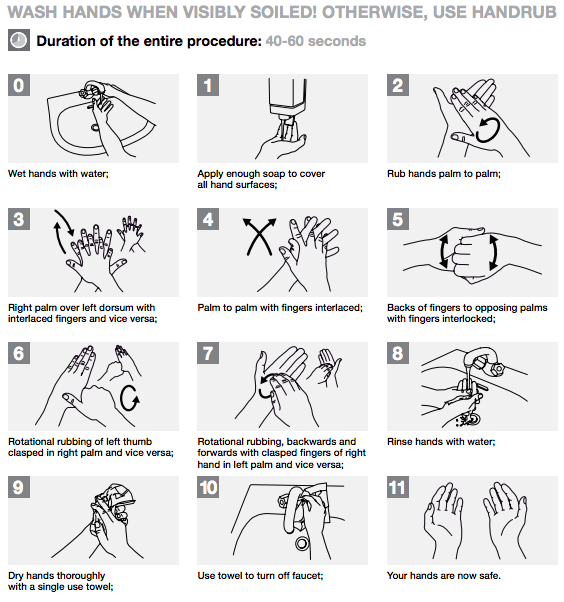Reviewing the literature about hand hygiene
- 1) What is the most missed site when washing your hands?
- A. Palm
- B. Dorsal (back) side of the hand
- C. Finger tips
- D. Between the fingers
- E. Thumbs
- F. Wrists
- 2) Who’s better at washing hands?
- A. Physicians
- B. Nurses
- C. Women
- D. Men
Since the COVID-19 pandemic has reached the states, I’ve been inundated with information. We all need to do our part to #flattenthecurve. We do this through social distancing and hygienic practices with an emphasis on hand washing and avoidance of touching the face. Hand hygiene is something that not only for healthcare workers but something everyone can improve upon! As part of my Sunday morning at home with my baby son, after streaming a church service and eating a peanut butter sandwich, what did I do? Read up on studies about hand hygiene!
There’s a fair amount of hand hygiene literature, but after delving into it, there’s a scarcity in data about exactly “how” one should wash their hands. Moreover, literature defining the most “missed” areas of the hands was even more uncommon!
From the papers I did find and read:
- One study showed the most missed sites were the:
- Dorsal (back) side of the fingers near the nails
- Thenar eminence (thumb)
- Area near the wrist crease
- Dorsal (back) side of the hand
- Multiple studies showed that:
- Women are more effective than men in hand hygiene
- Nurses are more effective than physicians!
- Multiple studies showed wearing/having these items decrease hand hygiene effectiveness:
- Rings
- Bracelets
- Watches
- Long nails (especially >2mm)
- Other conditions that were associated with decreased hand hygiene effectiveness:
- The weekend!
- ICUs (vs medical floors)
Studies differed on exactly which site was the most missed. Fingertips (especially the dorsal aspect) were cited multiple times as the area most commonly missed (1, 3). Other studies showed the thumb or the back of the hand as most missed (2). I found it useful knowing that jewelry and even lotion can compromise hand hygiene (4). One study stated all rings except for wedding rings showed a decrease in efficacy. Of course, it was not surprising that multiple studies showed male physicians as the worst group to wash their hands! And if you wondered if soap or alcohol rubs worked better against viruses, there’s evidence both are effective and are recommended. (Answers to above: 1) c, 2) B and C)
I would recommend following the WHO 6-step procedure for washing your hands because they hit the most missed areas. The studies differed in what technique people used to wash their hands, but for the most part, they used the WHO 6-step procedure. Personally I am now paying more attention to my fingertips and thumbs which I have not really being washing well prior to reading the literature. There’s evidence that washing your hands for more than 20 seconds is most efficacious. I’ve personally sung the Pokemon theme song to accomplish this. (https://washyourlyrics.com/).
The Research
If you’d like to peruse all the research articles and papers I read with my notes on them, they are listed here: https://www.evernote.com/l/ACmjJK6nZi9N26Lt9yht_fw8eqeDOLMrG6k
I’ve cited and summarized a few most significant papers here:
1) Szilágyi, L., Haidegger, T., Lehotsky, Á. et al. A large-scale assessment of hand hygiene quality and the effectiveness of the “WHO 6-steps”. BMC Infect Dis 13, 249 (2013). https://doi.org/10.1186/1471-2334-13-249
https://bmcinfectdis.biomedcentral.com/articles/10.1186/1471-2334-13-249
- Results
- “The most frequently missed sites were identified on the
- dorsal side of fingers in the proximity of the nails (16%)
- on the thenar eminence and in the proximity of the wrist crease (18%).:
- Failure to adequately clean:
- “the dorsal and (24%)
- palmar aspects of the hand (18%)
- Fingertips were missed by 3.5% of subjects.”
- “The analysis based on 4642 records showed that
- nurses performed best (77% pass), and
- women performed better than men (75% vs. 62%, p<0.001).”
- “The most frequently missed sites were identified on the
- My notes
- Health care workers doing the WHO 6-step hand rubbing technique

2) Vanyolos, E. Usage of Ultraviolet Test Method for Monitoring the Efficacy of Surgical Hand Rub Technique Among Medical Students. Journal of Surgical Education. Volume 72, Issue 3, May–June 2015, Pages 530-535
https://www.sciencedirect.com/science/article/abs/pii/S1931720414003316
- Methods
- Digital images of the hands of 253 medical students were analyzed during “Basic Surgical Techniques” course on the 10th (Survey 1) and 14th (Survey 2) week of the curriculum to check the process and the skills development. The last step of the surgical hand rub was performed with a fluorescent solution, and then the hands were placed under UV light. Photographs were taken and analyzed. Every uncovered area was considered an error. Number and the localization of missed spots and its extent was determined. For evaluation, palmar (P) and dorsal (D) sides of the hands were divided into regions of interest (1—distal phalanxes, 2—thumb and first metacarpus, 3—second to fifth fingers, and 4—second to fifth metacarpals).
- Results
- Various magnitude and number of failure occurred in 123 (48.61%) students in survey 1 and in 65 (25.69%) in survey 2.
- The most frequent sites of the missed spots were D/2 and P/4 region in survey 1 and D/1 and P/4 in survey 2.
- There was an improvement seen in survey 2, as shown by a decrease in the number and extent of missed spots. Right-handed students made fewer mistakes on their nondominant hands than left-handed students (n = 23) did.
- My notes
- Medical students doing 5-minute surgical scrubs

3) Wong, J. The Common Missed Handwashing Instances and Areas after 15 Years of Hand-Hygiene Education. Journal of Environmental and Public Health. Volume 2019. Article ID 5928924. https://doi.org/10.1155/2019/5928924
https://www.hindawi.com/journals/jeph/2019/5928924/
- Methods
- The outbreak of severe acute respiratory syndrome (SARS) claimed the lives of 286 Hong Kong people in 2003. Since then, the Hong Kong government has been promoting the benefits of proper hand hygiene. There are few studies that explore the general quality of handwashing and the hand-hygiene practices of the public of Hong Kong; given this, the aim of this study is to explore this neglected topic. This study is a quantitative study that was conducted in January 2018.
- After obtaining informed consent from them, the participants were asked to rub Glo Germ gel in their hands. After the rater confirmed that both hands were fully covered by the gel, the participants were asked to wash their hands under running water in a way that was typical for them. When the participants were washing their hands, the rater stood far behind them and recorded the time it took them to complete the process. After the participants had washed their hands, a portable, rechargeable black box with 10 watts of UV light was used to assess the residual fluorescent stains on the hands of the participants. The rater then recorded the results.
- Results
- The results show that the majority of participants only wash their hands after using the toilet (87%) or handling vomitus or faecal matter (91%).
- The mean duration of handwashing was 36.54 seconds (SD = 18.57).
- The areas of the hand most neglected during handwashing were the:
- fingertips (48.1%),
- medial area (30.5%),
- and back of the hand (28%).
- A multiple logistic regression shows that participants who have reached third-level education or higher often tend to be more hand hygienic than those who have not reached third-level education (, B = 1.003). Thus, participants aged 30 and above tend to neglect 5 more areas of the hand than those aged below 30 (, B = 4.933).
- My notes
- Non-healthcare workers off the street who washed hands as they normally would
4) Hautemaniere, A. Factors determining poor practice in alcoholic gel hand rub technique in hospital workers. Journal of Infection and Public Health (2010) 3, 25—34.
https://www.ncbi.nlm.nih.gov/pubmed/20701888
- Objective
- “Evaluate factors associated with poor hand hygiene effectiveness of hospital workers using an alcohol-based hand gel and the effect of an education program.”
- Methods
- “A direct observational prospective study of hand hygiene effectiveness prior to training and immediately after training. 3067 hospital workers of different professional categories in several hospital units in the University Hospital of Nancy (France).”
- Results
- Increased effectiveness
- “Time after program start (OR 0.97, 95%CI 0.96—0.97)
- and being female (OR 0.37, 0.24—0.58) were highly associated with increased effectiveness of hand hygiene prior to training.
- Professional background was also a strong predictor with nurses and especially senior nurses demonstrating much better effectiveness than all other professional groups.”
- Decreased effectiveness
- “Wearing rings other than a wedding ring (OR 1.8, 1.2—2.7),
- a bracelet (OR 2.0, 1.1—3.6),
- a watch (OR 1.9, 1.3—2.9)
- and having long nails were associated with ineffective hand rub use.”
- “Wearing wedding rings or long sleeves, and having varnished nails, visibly dirty hands prior to washing and cutaneous lesions were not associated with effective gel use.”
- Increased effectiveness
How to wash your hands
From the WHO:


Leave a Reply